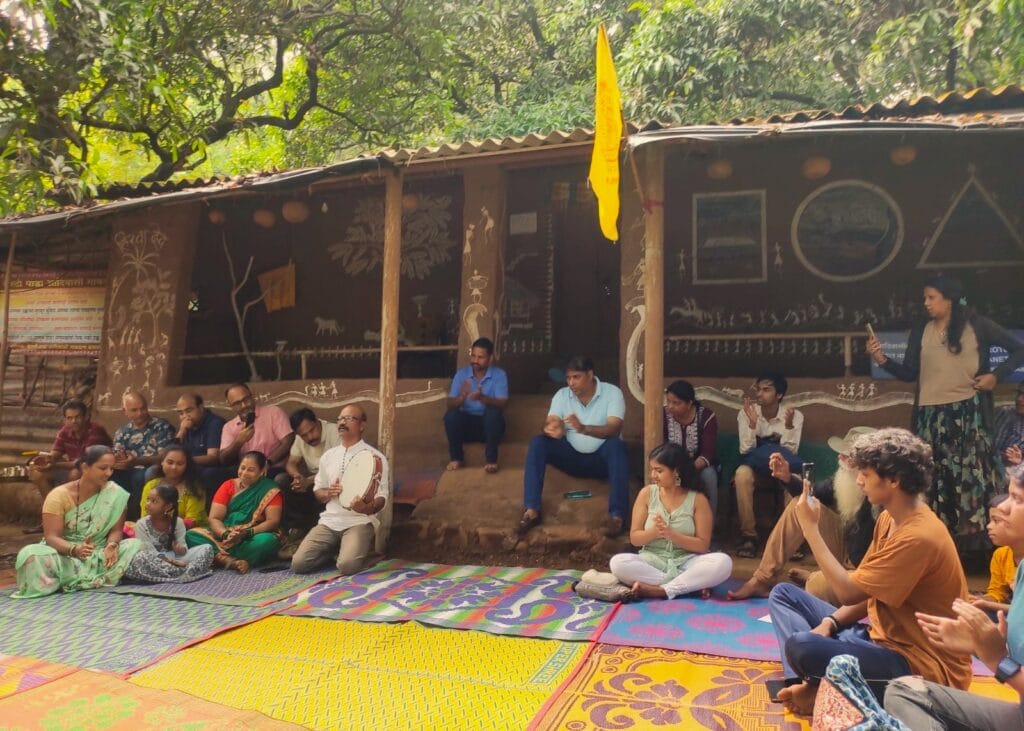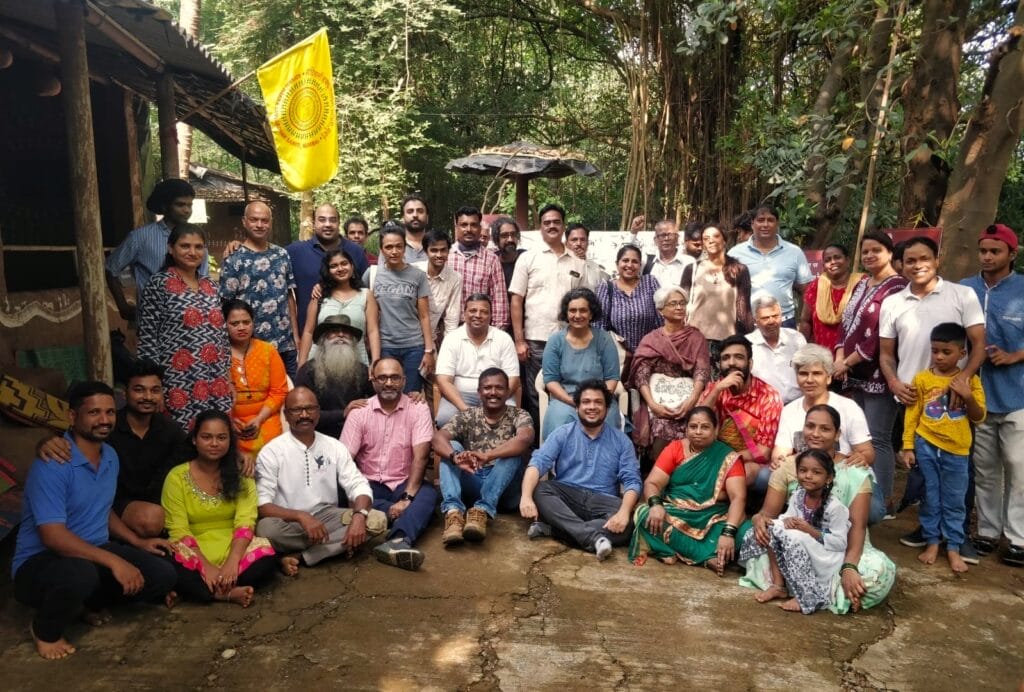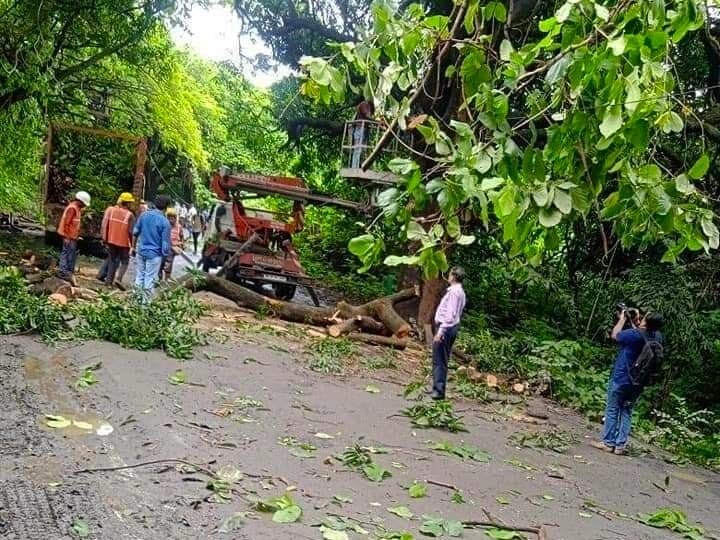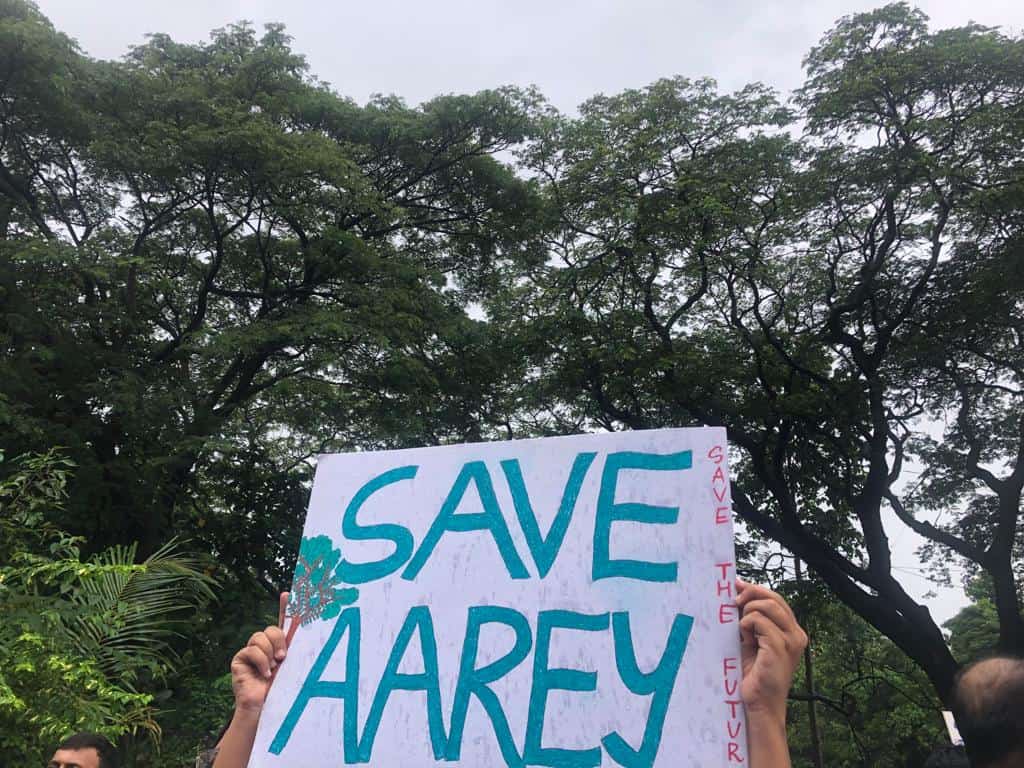On the afternoon of 26 November, 2023 a group of about 50 people gathered for a unique meeting at tribal activist Prakash Bhoir’s house at Mumbai’s Aarey forest. Members shared anecdotes, recalled incidents as they came together to commemorate their nine-year-long fight to save Aarey forest from concrete urban projects, especially the 33 hectare-Metro 3 car shed.
Dafli in hand, Prakash, a prominent tribal face from Mumbai now, sang a song he wrote on Aarey. He recalled the night of October 4, 2019, when his wife Pramila Bhoir was arrested for opposing the massive tree cutting.
“We were just going to have our dinner, when we heard about trees getting chopped. My wife said if we wait for dinner, we would lose more trees. That night I returned alone without her, as she got arrested. Two days later, she came home after many turned up to free her,” recalls Prakash. “When I initially decided to oppose tree cutting, I was almost alone. But soon many joined the movement to save trees,” says Prakash.
Nandkumar Pawar, who fights for the rights of the fishing community, recalled the times when he sneaked himself and Zoru Bhathena into the BMC’s fact finding team visiting Aarey. Together, they got them to “see the lies they were fed by the government officials”.
Today, the metro car shed is a reality at Aarey and so is the process of ‘monetisation’ of land parcels of Aarey for which a consultant is being appointed.
The get-together marked the nine years since their first on-ground protest meeting. The first meeting organised by Manish Gadia on November 23, 2014 at Tukaram Omble garden proved to be a milestone. It attracted Mumbaikars from different parts of the city who wished to get involved to save the forest.

As it would unravel, the Aarey movement has become historic for the city and its people. Since then, many supporters of the movement have come from far and wide. They joined hands to save the 3000 acres of unique biodiversity hotspot in a concrete city like Mumbai that was home to nine leopards and 76 species of birds, 80 species of butterflies, 16 species of mammals and 38 species of reptiles. Not to mention around 10,000 people in 27 tribal hamlets alongside 400 types of plants.
Prakash Bhoir recalls how people kept joining in the movement to save Aarey after he decided to fight rather than give in to the forces that were out to destroy the forests. That resolve marked the beginning of the save Aarey movement. As the tree cutting procedures began, more and more residents started getting agitated and thus emerged a powerful, united voice from citizens to protect its green cover.
Read more: Despite CM Uddhav Thackeray’s support, fight to save Aarey far from over
Connecting people
It was almost magical the way the forest and movement brought people together.
People from the world of advertising, banking, architecture, engineers, entrepreneurship, actors and even pastors did their bit to save Aarey from rapid urbanisation that gnawed at the green cover. Sometimes it was the informal settlements, other times skyscrapers and various infrastructural projects.
Activists, who fought to save the forests, say it has changed them forever. Those who came in to save Aarey, continue to be inspired by it. They are actively involved in fighting for various other environmental causes.
Even those, who had a brief or peripheral association with the movement, had an everlasting impact – like me.
I recall while walking back with naturalist Renee Vyas after her tree trail at Aarey, a constable from the wireless station atop the Aarey approached her. He invited her to the police compound to inspect two infected trees that were not responding to pesticide treatment.
Renee suggested him some tips and promised to revert to him after consulting other experts. When the constable mentioned, how his senior official too was a nature lover and how they were keen to plant more trees, more discussions and tips followed on species, spacing and watering schedules. It was a simple example of how strangers ended up collaborating for the city as part of the larger Aarey network.

On yet another occasion, my daughter, who had accompanied me to an Aarey meet, cursorily happened to mention her wish to climb a Banyan tree. Abhay Azad immediately swung into action and helped her climb a Banyan nearby. Such experiences are unimaginable and extremely rare to find in a city like Mumbai and she was thrilled to bits about it.
Long after she climbed down, Abhay stayed atop the tree, soaking in the view and the moments. All this while another bunch of rap artists like Elijah Immanuel sang along with musicians and played instruments and generally just relaxed and hung out at a stretch near Aarey nursery better known as the “Seeds of Banyan.”
It was a ‘Sundays for Aarey’ afternoon, where people met to speak for Aarey in Aarey.
How did the movement change Mumbai?
The Save Aarey movement changed the core of the city in many ways. “This was probably the next biggest environmental movement after the Chipko movement. I have heard of the Save Aarey movement even in Kenya, as it is an inspiration for those fighting to save the environment,” says Jalpesh Mehta, founder of Empower Foundation.
It also got Mumbaikars, known for their indifference about civic issues, to rally together and take active interest in neighbourhood issues, specifically the depleting tree cover. Developers started promising Miyawaki gardens in new buildings. The Bombay High Court also monitored if the trees that were cut were transplanted properly and adequately compensated with afforestation.

Officials of the BMC’s tree authority, that grants tree-cutting permissions, were gheraoed, questioned. Zoru Bhathena talked about how BMC officials suddenly became careful and ensured that blanket permissions to cut roadside trees for infrastructural projects were refused. The low-profile garden departments and the horticulturists of local ward offices were suddenly abuzz with citizens visiting to raise concerns about trees in their neighbourhood.
Increasing awareness about their local environment meant that the BMC suddenly found questions being raised about trees and the delayed tree census, the procedures followed etc.
In Vile Parle, the chopping of a century-old Peepal tree led to public uproar and even police complaints. In Santacruz, residents took interest and spent money to ensure successful tree transplantation. It was as if citizens had suddenly discovered that the citizens must step in to save their trees.
Onwards and upwards
Those who fought for Aarey continue to be actively involved in fighting for various other environmental causes.
Stalin Dayanand’s Vanashakti is working on environmental conservation of forests, mangroves and wetlands through education, awareness and litigation. Zoru Bhathena is now a tree activist fighting battles to save the city’s trees, parks, open spaces, Hanging Garden and even its coastline.
Amrita Bhattacharjee is now fighting for land rights of tribal communities and also for conservation of natural landscape and rivers in Aarey and the Sanjay Gandhi National Park. Rohit Joshi keeps fighting the legal battle to save the Yeoor forests and lakes of Thane from illegal encroachments and debris dumping.

Nandkumar Pawar, who hails from the fishing community, is fighting about environmental issues afflicting the livelihoods and concerns of the fishing community. Sanjiv Valsan, who led the rewilding Aarey initiative by undertaking tree plantations and their upkeep, continues to work for afforestation, tribal welfare and eco-cultural knowledge initiatives through his Waghoba Habitat Foundation.
While these are just a few examples, the movement inspired many to fight for environmental issues.
The Save Aarey movement may not have been successful in their fight against the Metro car shed, it may seem dormant now but the meeting was a way to remind themselves of how Mumbai’s forest got them to rise up to fight for the city and its future.
“The Aarey movement has shown that Mumbaikars, known for their indifference to civic issues, can come together and fight for a good cause,” says Stalin.
| The nine year journey |
2014 – Prithviraj Chavan proposes Metro car shed in 33 hectares or 81 acres of Aarey for washing, maintaining Metro coaches. It also includes plans for centralised operational control systems. November 2014 – Citizens come together to save Aarey after seeing tree-cutting notices pasted on trees at the proposed Metro 3 car shed site. December 2014 – Citizens file objections with the Tree Authority and move public interest litigation against cutting of 2298 trees in Aarey. Citizens also met up with municipal commissioner and Tree Authority members to request them to relocate the car shed from Aarey. January 2015 – The Tree Authority refuses NOC to cut trees in Aarey. The Bombay High Court disposes the PIL. Citizens simultaneously launch awareness drives and signature campaigns at societies, colleges and stations as also filing RTIs to obtain details and documents regarding the Metro 3 yard as well as forest status of Aarey. February 2015 – Citizens organise a protest rally and a chipko at the proposed Metro3 car shed site attended by about 1500 people. AdityaThackerey and Raj Thackerey also visit the proposed car shed site and commit their support to Save Aarey. March-April 2015- About 2500 people participate in a human chain organised at Marine Drive. Representations were made to the then chief minister Devendra Fadnavis and dairy development minister Eknath Khadse to relocate the car shed from Aarey. The CM appoints a technical Committee to explore options. May-June 2015 – Vanashakti and Aarey Conservation Group file a petition before the National Green Tribunal asking Aarey to be declared an Eco Sensitive Zone. August 2015 – The NGT orders restraining on construction activity inside Aarey Colony. September-October, 2015 – The CM’s technical committee recommends relocation of car shed from Aarey. But, MMRCL refuses. Dec 2016- February 2017 – Fadnavis directs Metro to consider Kalina for carshed. MMRCL refuses The state government brings out notification to dereserve 33 hectares of land in Aarey for commercial uses, Metro car shed and allied activities. Citizens file about 4000 objections with the Town Planning Department. April 2017 – MMRCL starts work on Soil Testing in Aarey near Unit 19 with a large contingent of police despite a status quo order from NGT. August 2019 – Tree Authority permits cutting of 2185 trees at Aarey. October 4, 2019 – The Bombay High Court dismisses PIL against Aarey. Overnight the entire area is cordoned and trees are cut. Mass protests erupt. Police arrest 29 persons, charge cases against 38 and detain many others. The tree cuttings were halted three days later on October 7 by a Supreme Court order thanks to intervention by a law student. By which time, MMRCL says it has cut 2141 trees, enough for the project. December 2019 – Chief minister Uddhav Thackeray scraps car shed at Aarey. June 2021 – 800 acres of forest notified at Aarey. May 2021 – Maharashtra government sets five member committee to monetise land parcels of Aarey July 2022 – Government changes. New chief minister Eknath Shinde reverses decision, permits Metro 3 carshed at Aarey. March 2023 – State plans to appoint a consultant to develop Aarey, monetise and develop it for tourism. |
| What does the fight to save Aarey mean for you? Has it inspired you to look into environmental issues in your neighbourhood? Share your Aarey experiences with us at mumbai@citizenmatters.in. |